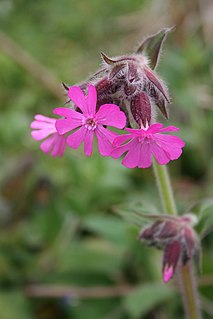
Silene is a genus of flowering plants in the family Caryophyllaceae. Containing nearly 900 species, it is the largest genus in the family. Common names include campion and catchfly. Many Silene species are widely distributed, particularly in the northern hemisphere.

Caryophyllaceae, commonly called the pink family or carnation family, is a family of flowering plants. It is included in the dicotyledon order Caryophyllales in the APG III system, alongside 33 other families, including Amaranthaceae, Cactaceae, and Polygonaceae. It is a large family, with 81 genera and about 2,625 known species.
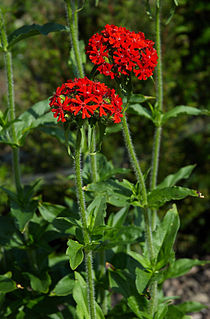
Silene chalcedonica, the Maltese-cross or scarlet lychnis, is a species of flowering plant in the family Caryophyllaceae, native to central and eastern Russia, Kazakhstan, Mongolia and northwestern China. Other common names include flower of Bristol, Jerusalem cross and nonesuch.

Silene flos-cuculi, commonly called ragged-robin, is a perennial herbaceous plant in the family Caryophyllaceae. This species is native to Europe and Asia, where it is found along roads and in wet meadows and pastures. In Britain it has declined in numbers because of modern farming techniques and draining of wet-lands and is no longer common. However, it has become naturalized in parts of the northern United States and eastern Canada.
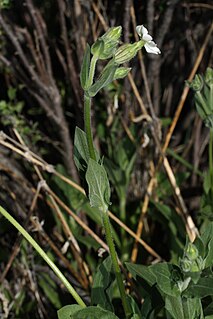
Silene latifolia subsp. alba, the white campion is a dioecious flowering plant in the family Caryophyllaceae, native to most of Europe, Western Asia and Northern Africa. It is a herbaceous annual, occasionally biennial or a short-lived perennial plant, growing to between 40–80 centimetres tall. It is also known in the US as bladder campion but should not be confused with Silene vulgaris, which is more generally called bladder campion.

Silene dioica, known as red campion and red catchfly, is a herbaceous flowering plant in the family Caryophyllaceae, native throughout central, western and northern Europe, and locally in southern Europe. It has been introduced in Iceland, Canada, the US, and Argentina.

Silene undulata is a plant native to the Eastern Cape of South Africa.

Silene campanulata is a species of flowering plant in the family Caryophyllaceae known by the common names Red Mountain catchfly and bell catchfly. It may be a synonym of Silene greenei.

Silene gallica is a species of flowering plant in the family Caryophyllaceae known by several common names, including common catchfly, small-flowered catchfly, and windmill pink. It is native to Eurasia and North Africa, but it can be found throughout much of the temperate world as a common roadside weed.

Asperula aristata is a deciduous species of perennial groundcover, and a flowering plant in the family Rubiaceae, known as woodruff. It is native to Morocco, Libya, Algeria, Tunisia, Azerbaijan, Georgia, Armenia, Greece, Bulgaria, Albania, Serbia, North Macedonia, Croatia, Italy, Austria, Switzerland, France, Spain, and Portugal.
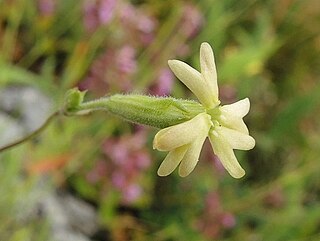
Silene flavescens are flowering plants part of the genus Silene, family Caryophyllaceae. They are widely distributed and are found in the northern hemisphere. They are native to Hungary and the Balkan Peninsula. It is an herbaceous species belonging to the tribe Sileneae

Silene otites, called Spanish catchfly, is a species of flowering plant in the genus Silene, native to Europe and the Transcaucasus area, and introduced to Xinjiang in China. It varies its floral odors to attract mosquitoes and moths at night and flies and bees by day. It is dioecious, with separate male and female plants.

Silene wahlbergella is a species of flowering plant belonging to the family Caryophyllaceae.
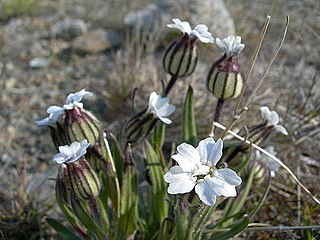
Silene involucrata is a species of flowering plant belonging to the family Caryophyllaceae.
Silene chlorantha is a species of flowering plant belonging to the family Caryophyllaceae.
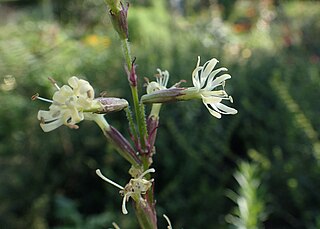
Silene tatarica, called the Tartarian catchfly, is a species of flowering plant in the genus Silene, found in north-central Europe and western Asia, from Germany and Norway eastwards to western Siberia and Kazakhstan. A specialist of riparian habitats, its seeds are dispersed by water.
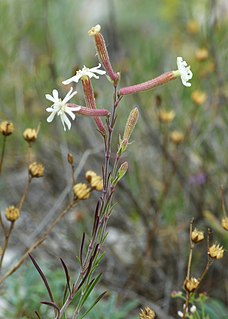
Silene supina is a species of flowering plant in the family Caryophyllaceae.

Silene rubella is a species of flowering plant in the family Caryophyllaceae. In Italy the species goes by the common name silene rosseggiante.
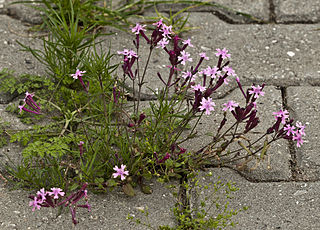
Silene aegyptiaca is a species of flowering plant in the family Caryophyllaceae. The common name for this species is Egyptian campion or Egyptian catchfly.

Silene sedoides is a species of Silene. It is widely distributed across the Aegean Sea but one of its subspecies is endemic to Greece.


















